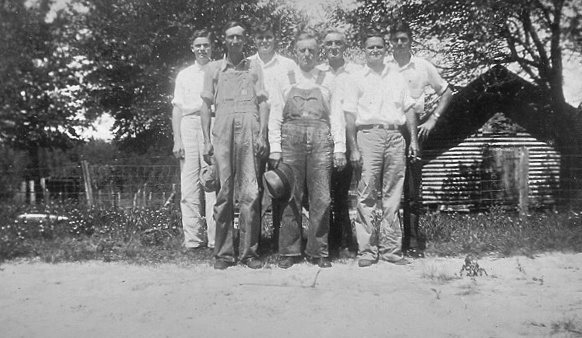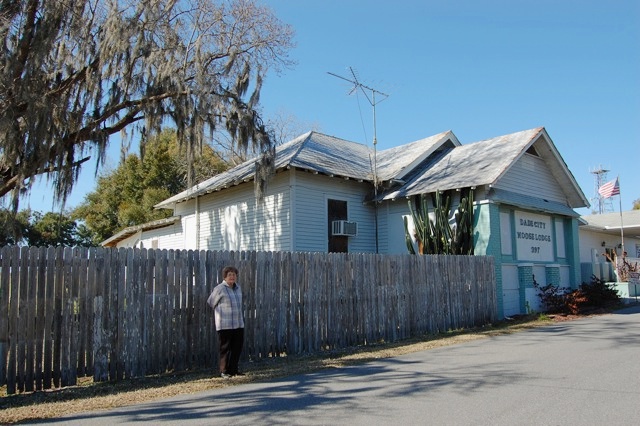HISTORY OF PASCO COUNTYLacoocheeLife on the Shaddock Place 1932-1933 By ARNO SURLS WEBSTER Like the rest of the world, Lacoochee suffered the effects of the economic depression that began in 1929, and lasted through the 1930s. I was five years old in 1929, and we were poor until I was in high school, but we were not impoverished; I didn’t realize we were poor since we always had plenty to eat, a decent house and we shared what we had. In fact, my father bought a new 1929 Ford Model A in June of 1929. I always had confidence in my parent’s ability to provide a home for my brother, Willie Mason (Bud) Surls, and me. They taught me to make the most of scarce resources but more importantly, they taught me by their example that by giving to others, my life would be enriched. I’d like to share some stories of those times with you. My father, Bill Surls, was a sawyer at Cummer Son’s Cypress Company sawmill, having moved to Lacoochee from Sumner after Cummer’s mill there burned. We lived in the quarters built for the mill workers by Cummer; the rent was fifty cents a week and was deducted from Daddy’s pay each payday along with the amounts of purchases that we had made at the company commissary on credit. Daddy kept abreast of news of the country and state by reading the newspaper and got his local news talking with his contemporaries at the mill before and after work; no doubt, they talked at the pool hall too. My mother, Helen, also brought news home from the Tin Town picture show where newsreels preceded the serial movies. As you have probably surmised, the news they were keeping up with exploded in 1929, Black Tuesday heralding the stock market crash. While the mill continued in operation, its product sales plummeted affecting the entire Lacoochee community. Men were laid off from the mill causing local businesses to decline since families had to curtail spending. But, as I recall, I don’t know of any that closed permanently due to the depression. The commissary stayed open as did the grocery store, Dr. Walter’s office, the barbershop, Abraham’s pharmacy, the garage, the picture show; all I can think of, but it was a hard time for them. In 1931, as the economy continued to founder, Daddy anticipated the closing of the mill; as I recall, Cummer management had a time line that they discussed with some of the men. Though Mama already managed the household expenses very frugally, Daddy told her and my grandmother, Elmira Surls, to cut back on all purchases and to begin preparing to move from the company quarters to a farm. There, we would be better able to sustain ourselves if Daddy and the other adults of our family could not earn money. At the time, our “family” consisted of Daddy, Mama, my younger brother, Bud, and me. My grandmother, Elmira, lived next door with Daddy’s sister Velma Surls and Curtis (Patty) Lane and his two girls, Eva and Martha (we always called her Tommie.) Elmira was mother to Eva and Tommie, their mother having died when Tommie was but a year old. Arthur and Ivy Ingram, and Pete Weeks boarded with Elmira; Daddy’s plan to move to the farm included all of them, though Arthur did not make the move with us. Using most of our cash, Daddy and Mama bought supplies to last the year; barrels of flour, coffee, sacks of sugar, sides of smoked bacon, a barrel of salt pork, some grits, a barrel of corn meal, a sack of black eyed peas, a sack of beans, a few bushels of sweet potatoes, a few sacks of onions, rice. That, along with fish from nearby ponds and the Withlacoochee River, and game hunted in the surrounding woods, had to sustain us until we could begin farming. During that year, Mama and Gramma stockpiled food, canning wild plum jelly made from the plentiful hog plums that they gathered in the nearby woods for free and bushels of vegetables, purchased in quantity from farmers at low cost. They used jars for canning that they scavenged from the dump near the “little mill,” amazed that people would throw away good jars in the time of want. Continuing to work at the mill, Daddy saved all he could. Shortly thereafter, the dreaded day finally came, though too soon to the struggling community – the mill shut down. Actually, the “little mill,” where pine trees were processed, shut down some time before the cypress mill; the veneer plant and crate plants closed when the cypress mill closed. With part of our money, Daddy rented the “Shaddock Place,” a ten-acre farm north of Dade City on Highway 301, prepaying the rent for two years. He then bought one sow, eight female shoats, three cows, a bunch of chickens and a horse named “Old Bill.” The move to the farm was made; now the Shaddock Place was home, 24 hours a day, 7 days a week. At the time of our move, there were two acres of cabbages on the farm, planted by the previous tenant. We were glad for a fresh vegetable to supplement our meals of canned vegetables and dwindling supplies of dry goods during those first months on the farm. The cabbages we didn’t eat, Daddy gave away. With the phases of the moon as our guide, we went to work and put in the crops; corn, velvet beans, and peanuts. Over time, we planted a big garden of peas, okra, tomatoes, butter beans, sweet potatoes and a small garden of squash, onions, peppers, collards, mustards, and turnips. Once the plants began to produce, it seemed there was not much variety, but there was always plenty. Most of the plant varieties ripened all at once. So in the summer we had lots of black eyed peas, but then only what we canned or dried until the next season; same thing with the mustards, collards and tomatoes, each in their own season. Mama, Gramma, Aunt Velma, Eva and Tommie worked very hard to can as much as they could. Root crops were stored under the house, loosely buried in the fine white sand, cool and dry until needed; putting them in or fetching them out was one of my chores. But, understand, we did not enjoy the bounty of the gardens all at once; our meals were plain though plentiful – lima beans and onions on many occasions. Our usual supper menu was corn bread, boiled cabbage, curds, boiled eggs, milk, coffee, water. For meat, we sometimes had rabbit, fish, soft-shelled turtles, robins in the winter, or duck on occasion. Later, our meals got better as we had other vegetables when the different plants in our gardens matured. When our chickens hatched eggs, Mama would raise the roosters for frying, but we still only had fried chicken occasionally. She made perlou – chicken and rice – when our neighbors came over for a ’party.’ She made it in our huge iron washpot, one chicken to a couple gallons of rice, but it was flavorful, filling and our friends enjoyed it. Unfortunately, our first hogs contracted cholera before they were big enough to slaughter. The only one who lived was Old Tildy and thereafter, she walked stiff-legged, but subsequently she had two large litters of pigs that we raised for slaughter. Having no refrigeration, we used several methods to prevent the meat from spoiling. Side meat was salted heavily and layered in barrels. The juices from the meat reacted with the salt creating a brine solution in which the meat was completely submerged. For cooking, sides were removed with a long fork – it was forbidden to let your fingers touch the brine solution. We rendered the fat into lard. A by-product of this process was cracklins – a treat. The hams and shoulders were sliced; and the remaining meat was ground and formed into patties. Both the sliced meat and the patties were pan fried and layered into steel cans, each layer covered with melted lard and the can covered with cheesecloth. The layers of lard solidified and protected the cooked meat from spoiling. Mama made hog’s head cheese, and I’m sure we ate all the remaining remnants of the hogs, most likely prepared with rice – neck-bones and rice being a favorite of hers in later years. We moved to the Shaddock place in the middle of the school year, so Bud and I caught the school bus for the trip into Dade City where we went to school for the last half of that school year. Tommie still went to school in Lacoochee; she rode with Miss Clark and Miss Revels who passed our place on their way to work as teachers there. When school started the next fall, Bud and I went back to Lacoochee school after Mama made arrangements for us to ride with them as well. Other than going to school, I don’t think the three of us went to Lacoochee the two years that we lived at the Shaddock Place. In the picture below, taken at the Shaddock Place on Highway 301 north of Dade City, I am wearing my “good dress” that I wore to school every day. From red and blue bandanas and a scrap of green material, my mama made three sets of trim for my dress. Each night, she would wash and iron my dress, remove the trim and replace it, alternating the trim daily so that it appeared that I had three dresses for school. My mama was a wonderful person. Until it re-opened, the mill made some provision for their key employees and Daddy was one of them. Every Friday, he went to work at 8:00 a.m., met with all the others; they talked, drew their pay, $5.00, went back home: wages to care for nine people – plus. But it was cash and all were grateful. It also gave them hope that as long as they were “employees” the mill would resume operations some day. These men needed hope as much as they needed the five dollars. Highway 301 went through the Shaddock Place; two acres on the west side, and eight acres to the east. The big old house, livestock pens and chicken roost were on the west side with a broad front yard facing the highway, shaded by a large oak tree. Across the highway were the crop fields and gardens that we farmed. As times got harder, traffic became less. We saw days when no car passed all day. One day a man and wife walked up and asked if they could get something to eat. It was right at suppertime so Mama told them where to wash up and we welcomed them to eat with us. The gentleman kept saying, “Please pass the cottage cheese,” referring to the bowl of curds. Our family had never heard of cottage cheese and had the poor man not been so hungry, we may have snickered. They told us that they had left their home up north, hoping for a better life in Florida. The man could not find work, so with their money running out, they started traveling back up the state, trying to get back to their former hometown. Eventually they had to make their way begging for money for gas, but finally even that ran out. Having no prospects for more gas, they were forced to abandon their car and just got out, shouldered their belongings and started walking north. When they arrived at our house, they had not eaten for several days. They spent the night and after a good breakfast, Mama and Gramma packed them a sack of food; they waved goodbye and resumed walking north. On another occasion, there had been no cars pass for several days. When we heard one coming from the south, we all stopped what we were doing and turned our attention to the road; even a car passing had become a novelty to our isolated farm life. Our curiosity was piqued as a big cloud of smoke approached surrounding a car that sputtered to a stop in our big front yard under the oak. Some of you may remember that, at the time, people resorted to using kerosene instead of gasoline in their cars because it was only five cents a gallon; the engines ran rough and smoked, but they ran! Moments after the car had coughed to a stop, a man, his wife and six children emerged. The man asked for something to eat for his children. Because it was the middle of the afternoon, nothing was cooked. From their emaciated appearance, Gramma thought that they needed something you could fix in a hurry. The man told her that they had been camping since they had been on the road so they had their own pots and pans and could cook for themselves. To get them started, she gave them the ingredients to make corn bread. The man made a fire and put lard in the skillet while his wife mixed up the corn meal. The children were so hungry that they would grab raw meal and eat it, but as soon as it hit their stomachs, they would retch and back it would come. Concerned with the starving condition of the children, Gramma went back to our house and returned with two big bowls of clabber. She told the man to delay cooking the cornbread until after they had fed the children something they could keep down. They spoon fed the clabber to them a little at a time until they were able to tolerate food in their stomachs. After that, Mama brought them some dry black-eyed peas and cabbage to cook with their cornbread. The next morning, we gave them food to cook for that day. Daddy gave them a dollar; off they went, smoking. As a child growing up during the depression, I understood poverty, privation, and fear – – I saw it all around me. But I never felt poor, deprived or helpless because my parents planned ahead, worked hard, and had confidence in themselves. And, I guess you could say, “giving” was, and still is, fundamental to our family’s philosophy. Something my Gramma once said kind of sums it up: One day as she was bagging up food for some needy person a member of our family asked, “Gramma, isn’t that the last of our bacon?” “Yes,” she replied and dropped the bacon into the bag. “But Gramma. . . .” Gramma looked up from the bag with piercing black eyes and said in a voice edged with opprobrium, “Son, you had bacon this morning.” Memories of the tragic families who passed by our place have stayed with me throughout my lifetime. Any time I’ve thought I had it bad, I’ve always remembered them, hitched up my britches and forged ahead. I fervently hope that the people who chance brought by our farm, made it back home, back to their families.  Thanks to Ginger Webster Oliver for the contribution of this story and pictures. |
